National symbols of France
National symbols of France are emblems of the French state and French nation, and are the cornerstone of the republican tradition.
| Part of a series on the |
| Culture of France |
|---|
| People |
| Cuisine |
| Festivals |
| Religion |
| Art |
| Literature |
| Sport |
|
The national emblems of the French Fifth Republic are:
- The French flag
- The National Anthem: "La Marseillaise"
- Marianne, the allegoric figure of the French republic
- The official motto: Liberté, Egalité, Fraternité (Liberty, Equality, Fraternity)
- The Great Seal of France
- The Cockade of France
Other symbols include:
- The National Order of the Legion of Honour and the National Order of Merit
- Bastille Day, the French national Holiday celebrated on 14 July
- The capital letters “RF”, standing for “République Française” (French Republic)
- The Gallic rooster
- The Phrygian cap
Flag

The Flag of France is a tricolour, and consists in three vertical stripes of equal width, coloured in royal blue, white, and red. It is the only official French emblem, according to article 2 of the current Constitution of France, adopted in 1958.
Cockade
The cockade of France is the national ornament of France, obtained by circularly pleating a blue, white and red ribbon. It is composed of the three colors of the French flag with blue in the center, white immediately outside and red on the edge.
Anthem
The national anthem "La Marseillaise" was composed by Rouget de Lisle in 1792.
Marianne
Marianne embodies the Republic. A personification of liberty and reason, and a portrayal of the Goddess of Liberty, her bust is present in every city hall in France. Her face is also drawn on stamps. The name Marianne enabled the French people to take over the newborn Republic, by creating a popular figure with whom French people could easily identify.
Great seal

The Great Seal of France (French: Grand sceau de la République française) is the official seal of the French Republic. The Great Seal features Liberty personified as a seated Juno wearing a crown with seven arches. She holds a fasces and is supported by a ship's tiller with a cock printed on it. At her feet is a vase with the letters "SU" ("Suffrage Universel", "Universal suffrage"). At her right, in the background, are symbols of the arts (painter's tools), architecture (Ionic order), education (burning lamp), agriculture (a sheaf of wheat) and industry (a cog wheel). The scene is surrounded by the legend "RÉPUBLIQUE FRANÇAISE, DÉMOCRATIQUE, UNE ET INDIVISIBLE" ("French Republic, democratic, one and indivisible") and "24 FEV.1848" (24 February 1848) at the bottom.
The reverse bears the words "AU NOM DU PEUPLE FRANÇAIS" ("In the name of the French people") surrounded by a crown of oak (symbol of perennity) and laurel (symbol of glory) leaves tied together with weed and grapes (agriculture and wealth), with the circular national motto "LIBERTÉ, ÉGALITÉ, FRATERNITÉ".
Coat of arms
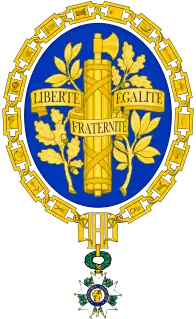
The current coat of arms of France has been a symbol of France since 1905.[1]
Diplomatic emblem
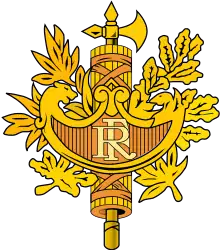
A different emblem appears on the cover of French passports; it had been adopted originally by the French Foreign Ministry as a symbol for use by diplomatic and consular missions in 1912, using a design by the sculptor Jules-Clément Chaplain.
Gallic rooster
The choice of the Gallic rooster as a symbol for France dates back to the collapse of the Roman Empire and the formation of Gaul. It finds its origin in a play on word on gallus (Latin for rooster) and Gallus (Gallic). Despite its frequent use as a symbol for France, in particular by sports federations, the rooster has never been an official emblem. “Cocorico !” (French for “cock-a-doodle-doo”) is often used as an affirmation of French patriotism.
Other RF and Tricolor-based emblems
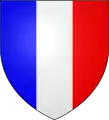 Shield on the Senate entrance
Shield on the Senate entrance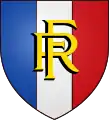 Sometimes used on a semi-official basis, but having no official status as the arms of the French Republic
Sometimes used on a semi-official basis, but having no official status as the arms of the French Republic
Historical emblems
One has been a symbol of France since 1912, although it does not have any legal status as an official coat of arms. It appears on the cover of French passports and was adopted originally by the French Foreign Ministry as a symbol for use by diplomatic and consular missions using a design by the sculptor Jules-Clément Chaplain.
 Official
Official
Cartouche of the French State (Vichy France; 1940–1944).svg.png.webp) Unofficial
Unofficial
Emblem of Philippe Pétain, chief of state of the French State, featuring the motto Travail, Famille, Patrie (Work, Family, Fatherland). The Francisque was only Pétain's personal emblem but was also gradually used as the regime's informal emblem on official documents. (Vichy France; 1940–1944) Unofficial
Unofficial
Emblem of Philippe Pétain, chief of state of the French State, featuring the motto Travail, Famille, Patrie (Work, Family, Fatherland). The Francisque was only Pétain's personal emblem but was also gradually used as the regime's informal emblem on official documents. (Vichy France; 1940–1944)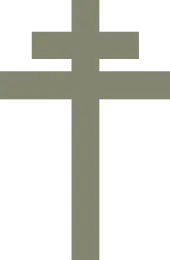
See also
References
| Wikimedia Commons has media related to Symbols of France. |
- "Les symboles de la République française". Site de la présidence de la République.
